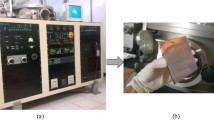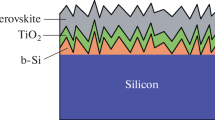Abstract
Multilayer structures based on semiconductor materials are being actively studied for their use in various solar energy detectors and converters. Due to the combination of properties of individual materials, an overall improvement of performance characteristics can be achieved in their multilayer design. In the present work, a technique for the preparation of layered structures based on PbS on the surface of silicon substrates has been tested for the first time. The principal possibility of chemical deposition of lead sulfide films from aqueous media at 80 °C by varying the initial state of the silicon substrate and the presence of the sensitive NH4Cl addition is presented. The morphology, elemental and phase composition, structural, and optical characteristics of the obtained lead sulfide films were studied by ICP, SEM-EDX, XRD and Raman spectroscopy. The photoelectrochemical effect of initial silicon substrates and layered PbS/Si structures was obtained using a solar simulator.






Similar content being viewed by others
Data availability
The authors confirm that the data supporting the findings of this study are available within the article [and/or] its supplementary materials.
References
D.G. Zakirov, Y.A. Slautin, Renewable and secondary power sources relevance for small-scale power generation in the Perm territory. Rus. Coal J. 4, 60–63 (2017). https://doi.org/10.18796/0041-5790-2017-2-60-63
Y. Al-Douri, M.M. Khan, J.R. Jennings, Synthesis and optical properties of II–VI semiconductor quantum dots: a review. J. Mater. Sci: Mater. Electron. 34, 993 (2023). https://doi.org/10.1007/s10854-023-10435-5
K.H. Aboud, S.M.H. AL-Jawad, N.J. Imran, Synthesis and characterization of flakes-like and flowers-like Ni: CdS nano films via hydrothermal technique for photocatalytic activity. J. Mater. Sci: Mater. Electron. 34, 933 (2023). https://doi.org/10.1007/s10854-023-10330-z
K. Kanchan, A. Sahu, B. Kumar, Numerical simulation of copper indium gallium diselenide solar cell with ultra-thin BaSi2 back surface field layer using the non-toxic In2Se3 buffer layer. Silicon. 14, 12675–12682 (2022). https://doi.org/10.1007/s12633-022-01983-2
R. Abdurakhimova, M. Laptev, N. Leonova, A. Leonova et al., Electroreduction of silicon from the NaI-KI-K2SiF6 melt for lithium-ion power sources. Chim. Techno Acta. 9, 20229424 (2022). https://doi.org/10.15826/chimtech.2022.9.4.24
M.K. Sahoo, P. Kale, Restructured porous silicon for solar photovoltaic: a review. Microporous Mesoporous Mater. 289, 109619 (2019). https://doi.org/10.1016/j.micromeso.2019.109619
A. Suzdaltsev, Silicon electrodeposition for microelectronics and distributed energy: a mini-review. Electrochem. 3, 760–768 (2022). https://doi.org/10.3390/electrochem3040050
X. Wang, X. Tian, X. Chen, L. Ren et al., A review of end-of-life crystalline silicon solar photovoltaic panel recycling technology. Sol. Energy Mater. Sol. Cells. 248, 111976 (2022). https://doi.org/10.1016/j.solmat.2022.111976
L. Wang, Y. Zhang, M. Kim, M. Wright et al., Sustainability evaluations on material consumption for terawatt-scale manufacturing of silicon-based tandem solar cells. Prog Photovolt. Res. Appl. (2023). https://doi.org/10.1002/pip.3687
J.-S. Cho, Y.H. Seo, A. Lee, S. Park et al., Energy-harvesting photovoltaic transparent tandem devices using hydrogenated amorphous and microcrystalline silicon absorber layers for window applications. Appl. Surf. Sci. 589, 152936 (2022). https://doi.org/10.1016/j.apsusc.2022.152936
J. Ajayan, D. Nirmal, P. Mohankumar, B. Mounika et al., Challenges in material processing and reliability issues in AlGaN/GaN HEMTs on silicon wafers for future RF power electronics & switching applications: A critical review. Mat. Sci. Semicond. Proc. 151, 106982 (2022). https://doi.org/10.1016/j.mssp.2022.106982
S. Aldawood, S.S. AlGamdi, S.A.A. Salman et al., Influence of γ-ray exposure and dose dependent characteristics of (n)PbS–(p)Si hetero-structure. J. Mater. Sci: Mater. Electron. 32, 11616–11627 (2021). https://doi.org/10.1007/s10854-021-05771-3
M.H. Patel, T.K. Chaudhuri, V.K. Patel, Solid state in situ thermolysis approach for synthesis of PbS/PEO/PVP nanocomposite films. J. Mater. Sci: Mater. Electron. 34, 667 (2023). https://doi.org/10.1007/s10854-023-10007-7
H. Lv, H. Wu, X. Wu, J. Zheng et al., Fabricating WS2/Mn0.5Cd0.5S/CuInS2 hierarchical tandem p-n heterojunction for highly efficient hydrogen production. Appl. Surf. Sci. 593, 153448 (2022). https://doi.org/10.1016/j.apsusc.2022.153448
B.Y. Castillo-Sánchez, L.A. González, Chemically deposited PbS thin films by reaction media with glycine for use in photovoltaics. Mat. Sci. Semicond. Proc. 121, 105405 (2021). https://doi.org/10.1016/j.mssp.2020.105405
J.H. Park, S.G. Ji, I.J. Park, S.K. Hwang et al., Sub-cell characterization of two-terminal perovskite/silicon tandem solar cells. Cell. Rep. Phys. Sci. 3, 101076 (2022). https://doi.org/10.1016/j.xcrp.2022.101076
M. Zamin, N.O. Balayeva, PbS nanostructures: a review of recent advances. Mat. Today Sust. 21, 100305 (2023). https://doi.org/10.1016/j.mtsust.2022.100305
D. Kumar, R. Bai, S. Chaudhary, D.K. Pandya, Enhanced photoelectrochemical response for hydrogen generation in self-assembled aligned ZnO/PbS core/shell nanorod arrays grown by chemical bath deposition. Mat. Today Energy. 6, 105–114 (2017). https://doi.org/10.1016/j.mtener.2017.09.004
M. Kord, K. Hedayati, M. Farhadi, Green synthesis and characterization of flower-like PbS and metal-doped nanostructures via hydrothermal method. Main Group. Metal Chem. 40, 35–40 (2017). https://doi.org/10.1515/mgmc-2016-0046
L.N. Maskaeva, I.V. Vaganova, V.F. Markov et al., Formation of CdxPb1–xS/Cd1–δS thin-film two-phase compositions by chemical bath deposition: composition, structure, and optical properties. J. Mater. Sci: Mater. Electron. 32, 19230–19247 (2021). https://doi.org/10.1007/s10854-021-06444-x
D.D. Uhuegbu, Growth and characterization of lead sulphide thin film for solar cell fabrication. J. Sci. & Ind. Res. 2, 230–241 (2011)
B.P. Singh, R. Kumar, A. Kumar, R.C. Tyagi, Vacuum deposition of stoichiometric crystalline PbS films: the effect of sulfurizing environment during deposition. Mater. Res. Express. 2, 106401 (2015). https://doi.org/10.1088/2053-1591/2/10/106401
Y. **ao, T. Xu, M. Zhang et al., Study of the quasi-single crystalline lead sulfide film deposited by magnetron sputtering and its infrared detecting characteristics. J. Mater. Sci: Mater. Electron. 33, 16029–16044 (2022). https://doi.org/10.1007/s10854-022-08494-1
F.K. Algethami, K. Trabelsi, A. Hajjaji, M.B. Rabha et al., Photocatalytic activity of silicon nanowires decorated with PbS nanoparticles deposited by pulsed laser deposition for efficient wastewater treatment. Materials. 15, 4970 (2022). https://doi.org/10.3390/ma15144970
W. Han, L.-Y. Cao, J.-F. Huang, Influence of pH value on PbS thin films prepared by electrodeposition. Mater. Technol. 24, 217 (2009). https://doi.org/10.1179/175355509X447195
P. Vidhya, K. Shanmugasundaram, P. Thirunavukkarasu et al., Enhancement of optoelectronic properties of PbS thin films grown by Jet nebulizer spray pyrolysis technique for photodetector applications: an impact of substrate temperature. J. Mater. Sci: Mater. Electron. 34, 1023 (2023). https://doi.org/10.1007/s10854-023-10406-w
M. Mohanraj, S. Aejitha, T. Govindaraj et al., Enhancement of physical properties of nebulizer spray-pyrolyzed PbS thin films for optoelectronic device application: an effect of Ag do**. J. Mater. Sci: Mater. Electron. 34, 643 (2023). https://doi.org/10.1007/s10854-023-09997-1
Ã.Ã. Üst, K. Dağcı, M. Alanyalıoğlu, Electrochemical approaches for rearrangement of lead sulfide thin films prepared by SILAR method. Mat. Sci. Semicond. Proc. 41, 270–276 (2016). https://doi.org/10.1016/j.mssp.2015.09.019
Z.K. Heiba, M.B. Mohamed, A.M. El-naggar et al., Structural and the optical characteristics of PbSx thin films. J. Mater. Sci: Mater. Electron. 33, 23270–23281 (2022). https://doi.org/10.1007/s10854-022-09093-w
L.N. Maskaeva, E.E. Lekomtseva, P.S. Bogatova, V.F. Markov et al., Structure, optical, and photoelectric properties of lead-sulfide films doped with strontium and barium. Semiconductors. 54, 1230–1240 (2020). https://doi.org/10.1134/S1063782620100231
R.K. Saryeva, N.S. Kozhevnikova, L.N. Maskaeva, V.F. Markov et al., Nanostructured Pb(S, O) films: synthesis, mechanism of deposition, and optical properties. Rus J. Phys. Chem. A 94, 2421–2427 (2020). https://doi.org/10.1134/S0036024420120262
S.R. Tippasani, S.V. Krishna, M.C.S. Kumar, Deposition time-dependent properties of PbS thin films. In: Rao, N.M., Lingamallu, G., Agarwal, M. (eds) Advanced nanomaterials and their applications. ICANA 2022. Springer Proceedings in Materials, vol 22. Springer, Singapore (2023). https://doi.org/10.1007/978-981-99-1616-0_6
E.V. Maraeva, A.A. Shupta, A.A. Bobkov, V.S. Levitskii et al., The photoluminescence and phase composition of lead sulphide–cadmium sulphide layers obtained by chemical bath deposition. J Phys. Conf Ser. 735(1), 012056 (2016). https://doi.org/10.1088/1742-6596/735/1/012056
M. Islam, H. Said, A. Hamzaoui, A. Mnif, Study of structural and optical properties of electrodeposited silicon films on graphite substrates. Nanomaterials. 12, 363 (2022). https://doi.org/10.3390/nano12030363
M. Laptev, A. Isakov, O. Grishenkova, A. Vorob’ev et al., Electrodeposition of thin silicon films from the KF–KCl–KI–K2SiF6 melt. J. Electrochem. Soc. 167, 042506 (2020). https://doi.org/10.1149/1945-7111/ab7aec
O.B. Pavlenko, Y.A. Ustinova, S.I. Zhuk, A.V. Suzdaltsev et al., Silicon electrodeposition from low-melting LiCl-KCl-CsCl melts. Rus. Met. (Metally) 2022, 818–824 (2022). https://doi.org/10.1134/S0036029522080109
Y.A. Parasotchenko, O.B. Pavlenko, A.V. Suzdaltsev, Y.P. Zaikov, Electrochemical nucleation of silicon in the low-temperature LiCl-KCl-CsCl-K2SiF6 melt. J. Electrochem. Soc. 170, 022505 (2023). https://doi.org/10.1149/1945-7111/acbabf
Funding
The research funding from the Ministry of Science and Higher Education of the Russian Federation (Ural Federal University Program of Development within the Priority-2030 Program) is gratefully acknowledged.
Author information
Authors and Affiliations
Contributions
All authors have contributed, discussed the results and approved the final manuscript.
Corresponding author
Ethics declarations
Conflict of interest
The authors declare that they have no conflict of interest.
Additional information
Publisher’s Note
Springer Nature remains neutral with regard to jurisdictional claims in published maps and institutional affiliations.
Rights and permissions
Springer Nature or its licensor (e.g. a society or other partner) holds exclusive rights to this article under a publishing agreement with the author(s) or other rightsholder(s); author self-archiving of the accepted manuscript version of this article is solely governed by the terms of such publishing agreement and applicable law.
About this article
Cite this article
Abdurakhimova, R.K., Tulenin, S.S., Leonova, N.M. et al. Production of PbS/Si structures by the hydrochemical deposition: composition, structure and properties. J Mater Sci: Mater Electron 34, 2113 (2023). https://doi.org/10.1007/s10854-023-11552-x
Received:
Accepted:
Published:
DOI: https://doi.org/10.1007/s10854-023-11552-x




